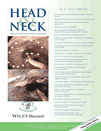Altered tissue electrical properties in squamous cell carcinoma in head and neck tumors: Preliminary observations†
Abstract
Background
The purpose of this study was to investigate tissue electrical properties in patients with head and neck cancer.
Methods
In the cross-sectional study direct bioimpedance measures (resistance, reactance, and phase angle) determined by bioelectrical impedance analysis (BIA) were performed on 31 patients with head and neck cancer and 31 healthy volunteers matched by age and sex as a control group.
Results
Phase angle at 50 kHz was found to be significantly lower (p = .000006) in patients with head and neck cancer than in the control group (4.69° ± 0.71 vs 5.59° ± 0.70, respectively). Resistance was significantly (p = .0002) greater in patients with head and neck cancer than in the control group (596.24 ± 96.31 ohm vs 513.73 ± 65.79 ohm, respectively).
Conclusion
Presurgical patients diagnosed with head and neck cancer have altered tissue electrical properties. Further observations would be valuable to calculate survival, validate the prognostic significance of phase angle, and monitor nutritional and therapeutic interventions in this patient population. © 2012 Wiley Periodicals, Inc. Head Neck, 2013




